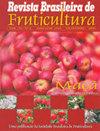番荔枝种子形态计量学研究。和胚胎生长在干燥的温暖的储存
IF 0.9
4区 农林科学
Q4 HORTICULTURE
引用次数: 0
摘要
在墨西哥,Annona purpurea Moc。在杜纳尔的山和家庭花园中发现了钦克亚。它被用作食物(水果)、传统药物(叶、茎、根、种子、树皮)、建筑木材、造纸、木工、制绳和燃料。没有足够的关于种子的信息,也没有关于发芽管理的信息,这是稀缺的,长期的和不稳定的。考虑到形态生理休眠是可能的原因,有必要在一个更广泛的项目中,从种子的特性开始,确定干热储存(DWS)对其的影响。胚的周长和长度由于子叶和下胚轴根轴长度的增加而增加,而中间的下胚轴面积减少,形成一个凹化胚。这些数据表明,由于DWS的影响,直到6个月,青果胚才开始发育并改变其形状。在干热贮藏期间,胚在种子内的发育证实了形态休眠的存在。本文首次报道了木瓜种子的胚胎发育和性状。本文章由计算机程序翻译,如有差异,请以英文原文为准。
Morphometry of chincuya seeds (Annona purpurea Moc. &Sessé ex Dunal) and embryonic growth under dry warm storage
Abstract In Mexico, Annona purpurea Moc. &Sessé ex Dunal, chincuya is found in mountains and family gardens. It is used as food (fruits), traditional medicine (leaves, stems, roots, seeds, bark), wood in construction, papermaking, carpentry, rope making, and as fuel. There is not enough information on the seed, nor on germination management, which is scarce, prolonged and erratic. Considering that the morphophysiological dormancy is the probable cause, it was necessary, within a broader project, to start with the characterization of the seed and determine the effect of dry warm storage (DWS) on it. The perimeter and length of the embryos increased due to the increase in length of the cotyledons and the hypocotil root axis, while the middle hypocotyl area decreased, forming an acinturated embryo. These data indicate that the embryos of chincuya are underdeveloped since they grew and modified their shape, due to the effect of DWS, until the 6th month. This development of the embryo within the seed during dry warm storage confirms the presence of morphological dormancy. This is the first report of embryo growth and characterization of chincuya seeds.
求助全文
通过发布文献求助,成功后即可免费获取论文全文。
去求助
来源期刊
CiteScore
1.50
自引率
20.00%
发文量
34
审稿时长
4-8 weeks
期刊介绍:
The Revista Brasileira de Fruticultura (RBF) publishes technical articles and scientific communications in the area of fruit crops, referring to results of original searches and unpublished papers in Portuguese, Spanish or English, and 1 or 2 reviews per edition, of invited authors.

 求助内容:
求助内容: 应助结果提醒方式:
应助结果提醒方式:


